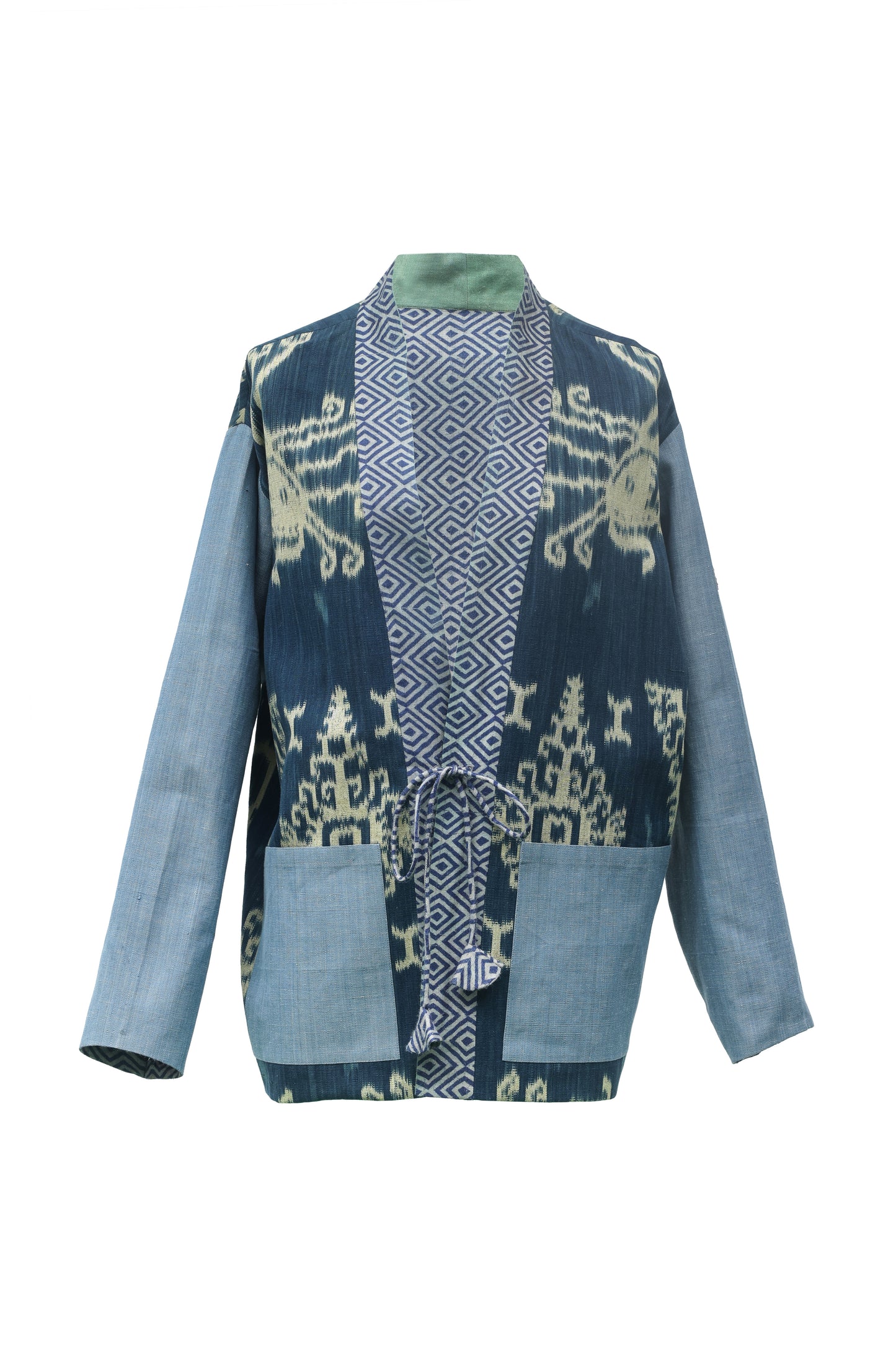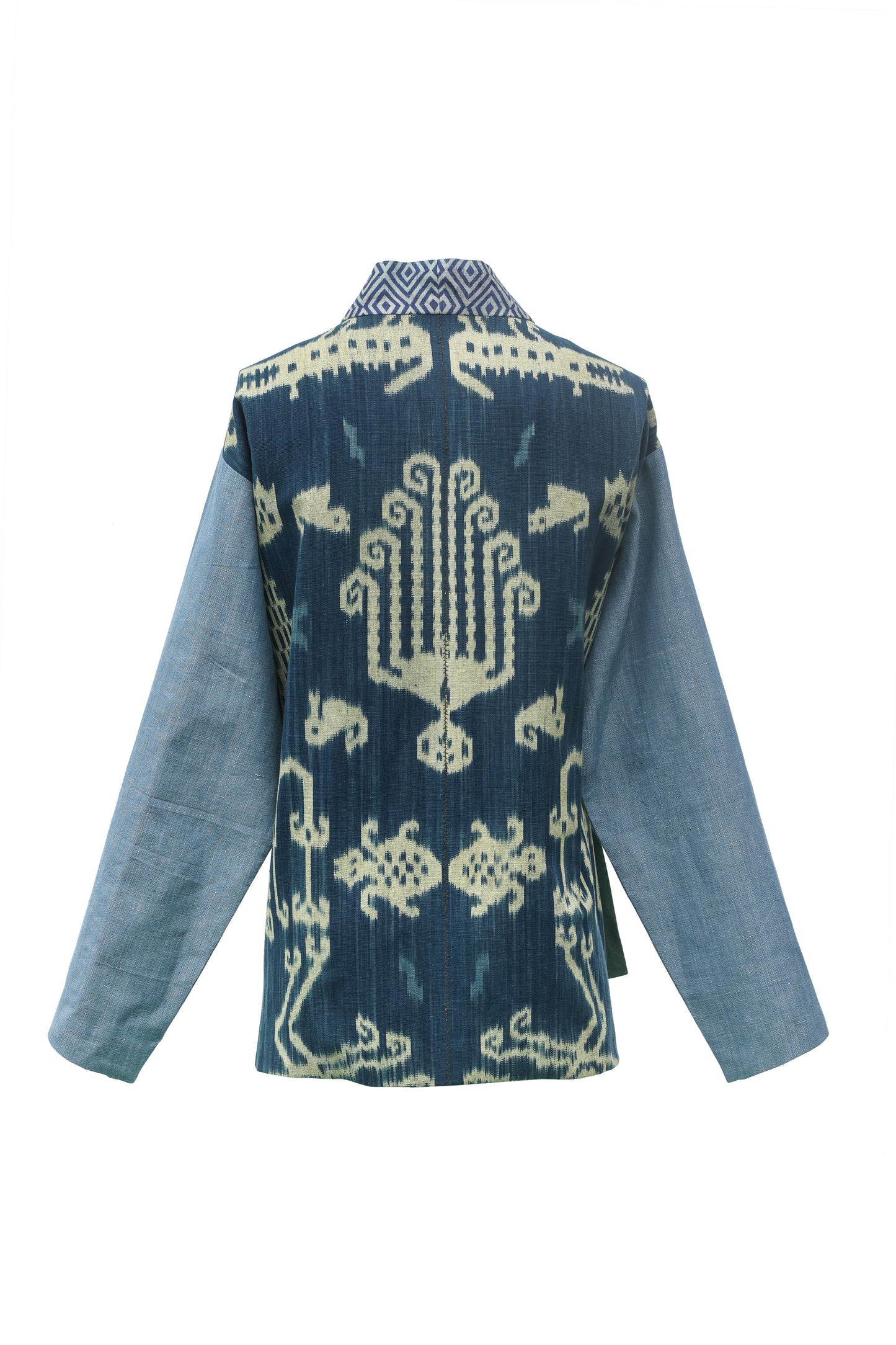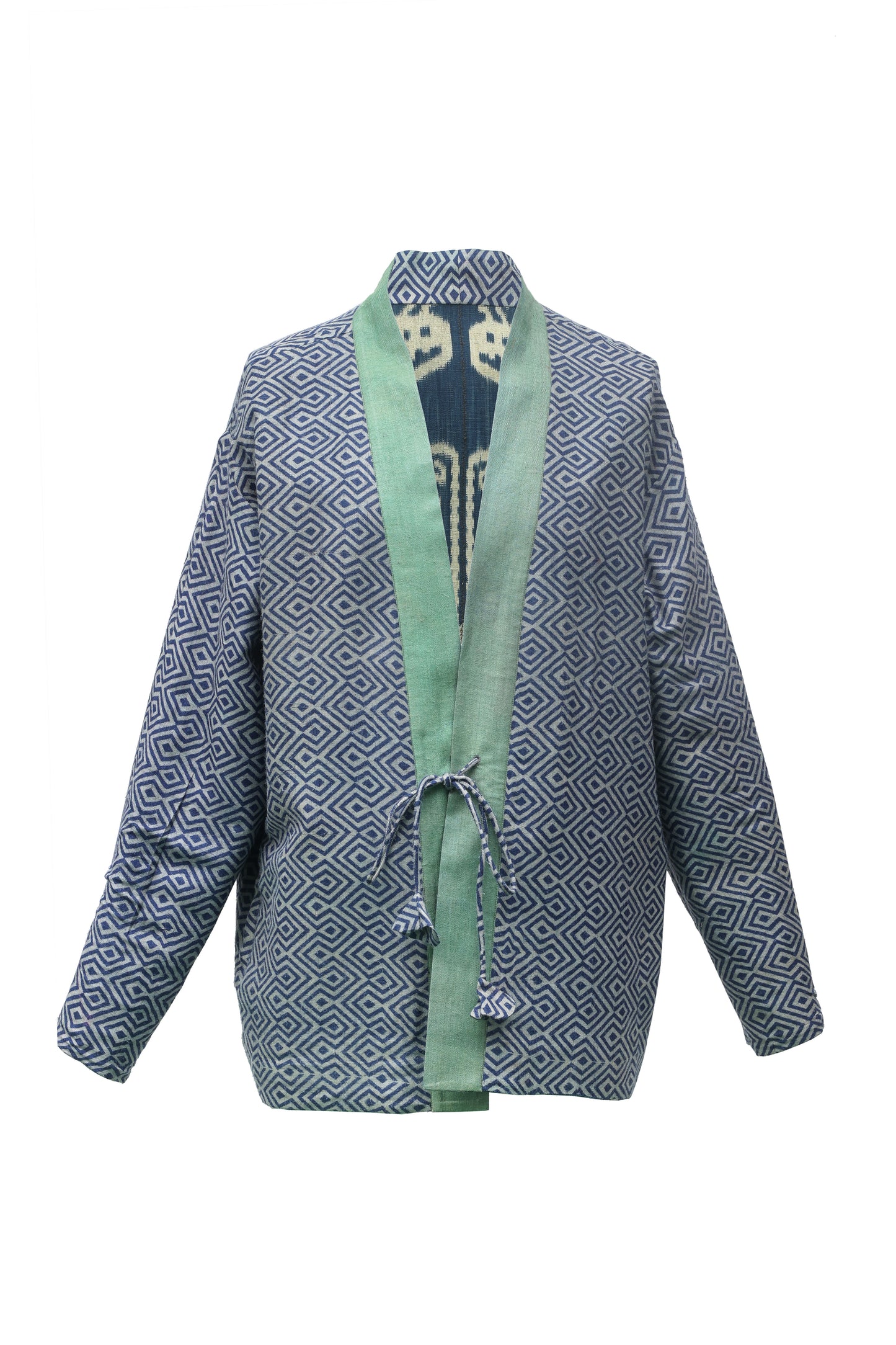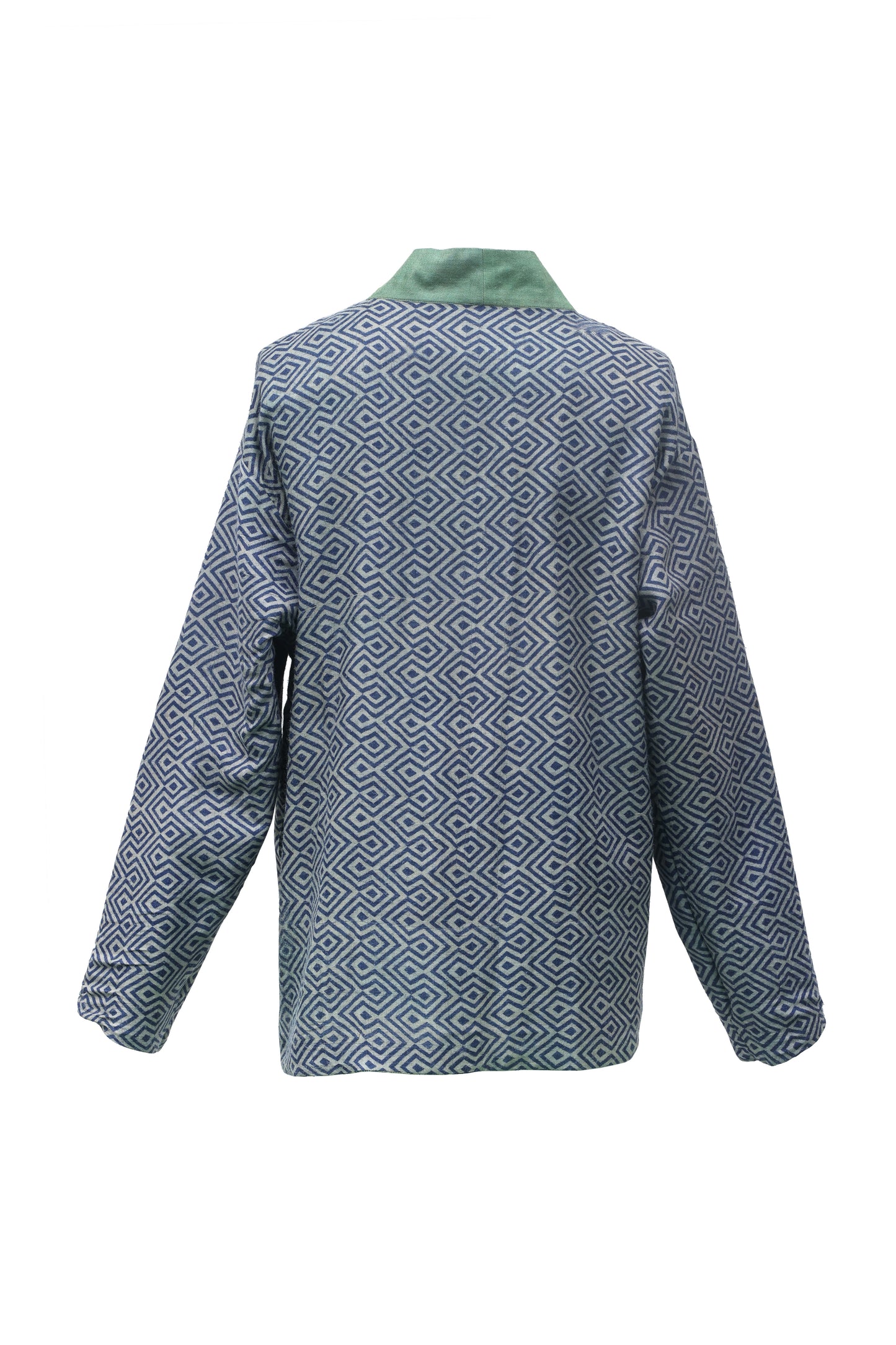KAJ.012
This one-of-a-kind garment is reversible and unique from each side.
This striking kimono style jacket is another gem in our Indigo range. It features vintage indigo Tenum Ikat from Sumba Indonesia combined with hand woven indigo dyed cotton from Wardha, Maharashtra on one side and the reverse is vintage handwoven wool from Jammu and Kashmir.
Sumba is an island that is part of the Lesser Sunda Islands in Indonesia, where textile traditions are very important, and imbue life from birth to death. Textiles are used for all kinds of ceremonial purposes, or to symbolize the wearer’s wealth and power. Sumbanese textile imagery combines influences from India, mainland Southeast Asia, and the Islamic world, as well as purely indigenous aesthetics, which refers to Sumba’s position along important trade and seafaring routes. Dutch colonial tastes also influenced textile imagery, and Dutch missionaries and colonists began collecting east Sumbanese textiles at the beginning of the 20th century. The commercialization and export trading of Sumbanese textiles began in the 1920s, which also coincided with the erosion of the aristocracy’s power, resulting in the relaxation of sumptuary laws. Until then, only the aristocracy, or maramba, could wear ikat woven in three colours (hinggi kombu), while commoners, or kabihu, could only wear ikat woven in two colours (hinggi kaworu).
Warp ikat is an intricate and labor-intensive weaving technique. The warp threads are dressed on the loom and then wrapped and tied (often with dried palm leaves) to form patterns. When the partially-bound threads are removed from the loom and placed in the dye bath, the bound sections resist the dye. The newly patterned warps then go back on the loom and are woven into cloth. The ikat technique produces individualized designs with slightly blurred edges; these variations provide dynamism within the repeated patterns. Like batik, the precise origins of the ikat technique remain uncertain, however, the variations in resist-dye processes throughout Indonesia, and the Indian Ocean world, strongly suggest an evolution through trade and migration.
The textile designs contemporary weavers choose to create reflect Sumba’s culture and highlight colonial legacies as well as ongoing transnational exchange. As anthropologist and textile scholar Jill Forshee has argued “Through time, the region’s textiles have been transformed consistently in their designs and uses, in response to influences within, between, and beyond village realms”.
Keynote from Karatoyaa:
• Please note, that due to antique nature of the fabrics there may be signs of past experiences - we believe it adds value and a meaning to the garments.
• Some naturally dyed fabrics even after lasting generations may leave colour
• Please keep in mind that all Karatoyaa pieces are Dry Clean only with the Professional service provider.
Couldn't load pickup availability
DETAILS
DETAILS
This one of a kind garment is reversible and unique from each side.
Part of our indigo range, this kimono style jacket is created using hand woven Ikat from Sumo, Indonesia, combined with natural indigo hand woven cotton from Wardha, Maharashtra, by the institution that supports indigenous, regenerative craft and farming practices. On other side there is a vintage screen printed wool from
Ikat (in Indonesian languages means "bind") is a dyeing technique originating from Indonesia used to pattern textiles that employs resist dyeing on the yarns prior to dyeing and weaving the fabric.
In ikat, the resist is formed by binding individual yarns or bundles of yarns with a tight wrapping applied in the desired pattern. The yarns are then dyed. The bindings may then be altered to create a new pattern and the yarns dyed again with another colour. This process may be repeated multiple times to produce elaborate, multicolored patterns. When the dyeing is finished all the bindings are removed and the yarns are woven into cloth.
Ikat is produced in many traditional textile centres around the world, including India to Central Asia, Southeast Asia, Japan (where it is called kasuri), Africa, and Latin America. Double ikats—in which both the warp and weft yarns are tied and dyed before being woven into a single textile—are relatively rare because of the intensive skilled labour required to produce them, especially in lining up the weft patterns.
The textiles of Sumba, an island in eastern Indonesia, represent the means by which the present generation passes on its messages to future generations. Sumbanese textiles are deeply personal; they follow a distinct systematic form but also show the individuality of the weavers and the villages where they are produced. Internationally, Sumbanese textiles are collected as examples of textile designs of the highest quality and are found in major museums around the world, as well as in the homes of collectors.
Since textiles are the products of Sumbanese women, they are viewed as tangible representations of the female element of the bipartite universe. In Sumba, this male-female dynamic is encapsulated in the notion of the Highest Being, who is both the Father Sun and Mother Moon, as well as the Creator or Weaver of human life. The Sumbanese believe individuals are able to acquire the special powers and qualities of certain creatures when textiles displaying such motifs are worn
Please note, that due to antique nature of the fabrics there may be signs of past experiences - we believe it adds value and a meaning to the garments.
Some naturally dyed fabrics even after lasting generations may leave colour
Please keep in mind that all Karatoyaa pieces are Dry Clean only with the Professional service provider.
COMPOSITION
COMPOSITION
UPCYCLED COTTON + WOOL
SIZE & FIT
SIZE & FIT
ONESIZE
waist - 146 cm
sleeve - 62cm
CARE
CARE
Please keep in mind that all Kārātoyaa pieces are Dry Clean only with the Professional service provider.
Share








